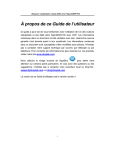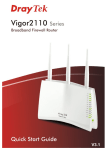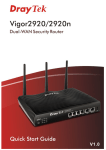Download Draytek Vigor2100 Installation guide
Transcript
Vigor2100 Series Quick Start Guide Copyright Information Copyright Declarations Copyright 2005 All rights reserved. This publication contains information that is protected by copyright. No part may be reproduced, transmitted, transcribed, stored in a retrieval system, or translated into any language without written permission from the copyright holders. Trademarks The following trademarks are used in this document: • Microsoft is a registered trademark of Microsoft Corp. • Windows, Windows 95, 98, Me, NT, 2000, XP and Explorer are trademarks of Microsoft Corp. • Apple and Mac OS are registered trademarks of Apple Computer Inc. Other products may be trademarks or registered trademarks of their respective manufacturers. Safety Instructions and Approval Safety Instructions • Read the installation guide thoroughly before you set up Warranty We warrant to the original end user (purchaser) that the router will be free from any defects in workmanship or materials for a period of three (3) years from the date of purchase from the dealer. Please keep your purchase receipt in a safe place as it serves as proof of date of purchase. During the warranty period, and upon proof of purchase, should the product have indications of failure due to faulty workmanship and/or materials, we will, at our discretion, repair or replace the defective products or components, without charge for either parts or labor, to the router. • The router is a complicated electronic unit that may be repaired only be authorized and qualified personnel. Do not try to open or repair the router yourself. • Do not place the router in a damp or humid place, e.g. a bathroom. • The router should be used in a sheltered area, within a temperature range of +5 to +40 Celsius. • Do not expose the router to direct sunlight or other heat sources. The housing and electronic components may be damaged by direct sunlight or heat sources. • Keep the package out of reach of children. • When you want to dispose of the router, please follow local regulations on conservation of the environment. whatever extent we deem necessary tore-store the product to proper operating condition. Any replacement will consist of a new or re-manufactured functionally equivalent product of equal value, and will be offered solely at our discretion. This warranty will not apply if the product is modified, misused, tampered with, damaged by an act of God, or subjected to abnormal working conditions. The warranty does not cover the bundled or licensed software of other vendors. Defects which do not significantly affect the usability of the product will not be covered by the warranty. We reserve the right to revise the manual and online documentation and to make changes from time to time in the contents hereof without obligation to notify any person of such revision or changes. Be a Registered Owner Web registration is preferred. You can register your Vigor router via http://www.draytek.com. Alternatively, fill in the registration card and mail it to the address found on the reverse side of the card. Firmware & Tools Updates Due to the continuous evolution of DrayTek ADSL & Router technology, all routers will be regularly upgraded. Please consult the DrayTek web site for more information on newest firmware, tools and documents. http://www.draytek.com ii European Community Declarations Manufacturer: DrayTek Corp. Address: No. 26, Fu Shing Road, HuKou County, HsinChu Industrial Park, Hsin-Chu, Taiwan 303 Product: Vigor2100 Series Residential Broadband Routers DrayTek Corp. declares that Vigor2100 series of routers are in compliance with the following essential requirements and other relevant provisions of R&TTE Directive 1999/5/EEC. The product conforms to the requirements of Electro-Magnetic Compatibility (EMC) Directive 89/336/EEC by complying with the requirements set forth in EN55022/Class B and EN55024/Class B. The product conforms to the requirements of Low Voltage (LVD) Directive 73/23/EEC by complying with the requirements set forth in EN60950. The Vigor2100VG/G are designed for the WLAN 2.4GHz network throughput EC region, Switzerland, and the restrictions of France. iii Regulatory Information Federal Communication Commission Interference Statement This equipment has been tested and found to comply with the limits for a Class B digital device, pursuant to Part 15 of the FCC Rules. These limits are designed to provide reasonable protection against harmful interference in a residential installation. This equipment generates, uses and can radiate radio frequency energy and, if not installed and used in accordance with the instructions, may cause harmful interference to radio communications. However, there is no guarantee that interference will not occur in a particular installation. If this equipment does cause harmful interference to radio or television reception, which can be determined by turning the equipment off and on, the use is encouraged to try to correct the interference by one of the following measures: ♦ Reorient or relocate the receiving antenna. ♦ Increase the separation between the equipment and receiver. ♦ Connect the equipment into an outlet on a circuit different form that to which the receiver is connected. ♦ Consult the dealer or an experienced radio/TV technician for help. This device complies with Part 15 of the FCC Rules. Operation is subject to the following two conditions: (1) This device many not cause harmful interference, and (2) This device may accept any interference received, including interference that may cause undesired operation. iv Table of Contents 1. Introduction………………………………………………………….….. 1 1.1 1.2 1.3 1.4 Brief Overview…………………………………………………………..……… Specifications………………………………………………………..…………. Front Panel LEDs and Rear Panel Interfaces………………..……….…… Package Contains…………………………………………………..…………. 2. Quick Install Your Vigor2100 Series Router……………..……….. 2.1 Hardware Installation……………………………….……………..………….. 2.2 Configure Your Router via Quick Start Wizard…………………..………. PPPoE-type……………………………………………………………….……… PPTP & Obtain IP automatically……………………………………..………… PPTP & Specify an IP………………………………………………..…..……… Static IP (fixed IP)………………………………………………...…...………… DHCP (for cable modem users)…………………………………...…………… Automatic QoS for VoIP………………………………………..……………….. 2 3 4 7 8 8 9 10 11 11 12 12 13 3. Wireless LAN Settings (for G models)……..………………….…… 14 3.1 General Settings…………………………………….…………………..……... 15 3.2 Security Settings…………………………………………….……………...…. 15 4. VoIP Settings (for V models)……...……………..……….……..….... 17 4.1 DialPlan Setup……………………………………….………………..…...…… 4.2 SIP Related Function Setup……………………….…………………..…...… 4.3 Calling Scenario…………………………………………………………….…. Calling via SIP Server.….……………………………………………..……...… Peer to Peer…………..……………………………………………..…………… 19 20 23 23 25 5. Trouble Shooting……………………………………………..………. 26 Is the Hardware Status OK?……………………………………………………. Are the Network Connection Settings on Your PC OK?…………………….. Can You Ping the Router from PC?………………………………..……….… Are the ISP Settings OK?…………………………………………………...…. Back to Factory Default Setting………………………………………………… i 26 26 28 29 30 1. Introduction Easy Internet-sharing of your broadband connection Robust firewall to help protect your network from external attacks For Vigor2100VG/V: Making regular phone calls over your broadband connection by simply plugging in your phone. QoS-assured VoIP facilities to deliver superior quality. Automatic failover for your Public Switched Telephone Network (PSTN) during power cuts. For Vigor2100VG/G: 802.11g Compliant Wireless LAN access with security features. 1 1.1 Brief Overview The Vigor2100 series broadband router/Firewall with a VoIP phone port, an Internet access solution for your LAN, which provides you with the shared web surfing and countless value-added features, such as Firewall, Security, VoIP, and 802.11g Wireless LAN (up to 54Mbps for Vigor2100VG and Vigor2100G only). These are all in a reliable one-box solution. Model comparison chart: Broadband Router VoIP Wireless AP Vigor 2100V Vigor2100G Vigor2100VG * * * * - * * * What does "PSTN life line" perform on Vigor2100V and Vigor2100VG? The Vigor2100V and Vigor2100VG have a “Line” port on the rear panel for connecting to a PSTN (regular analogue) line. The Loop Through option can be used to set an alternate telephone number for your contact on the PSTN, which the Vigor2100V and Vigor2100VG will dial instead of the SIP account if you lose ADSL access or power to the Vigor2100V and Vigor2100VG. Hence, the PSTN line can act as a lifeline (backup mechanism) for VoIP calls. The lifeline mechanism is activated automatically but can also be manually configured. 2 1.2 Specifications For Vigor2100V/VG For Vigor2100VG/G VoIP (Voice over IP) Supports one FXS(phone) port G.168 line echo-cancellation Gain control Jitter buffer Voice Codec: G.711 A/µ law, G.726, G.723.1, G.729 A/B, VAD/CNG Tone generation and detection: DTMF, Dial, Busy, Ring back Protocol: SIP, RTP/RTCP Wireless Access Point IEEE802.11b/g compliant Wireless client list Wireless security: 64/128 bits WEP encryption WPA/WPA2* PSK (IEEE802.1i) MAC address access control Hidden SSID Access point discovery* Wireless LAN isolation* WDS* LAN 4-port 10/100M Base-TX Ethernet switch DHCP server for IP assignment (up to 253 users) DNS cache and proxy Firewall Facilities NAT/PAT, DMZ host, port-redirect/open port SPI (Stateful Packet Inspection) DoS/DDoS protection Flexible URL content filtering Rule-based packet filtering E-mail alert and logging via syslog VPN pass through WAN/Internet One 10/100M Base-TX port with a RJ-45 connector Quick Start Wizard for Internet access DHCP client for cable service Static IP address assignment for fixed IP networks PPPoE client Router Management Quick Start Wizard Command Line Interface (Telnet) Telnet remote access support Built-in diagnostic function Firmware upgrade via TFTP/FTP Syslog SNMP management MIB-II (for Vigor2510V series) E-mail Detection LED flashes to indicate E-mail is waiting on your mail server (POP3) Power Consumption 15V DC 15Watt Network Features DHCP client/relay/server Dynamic DNS Call schedule Radius client UPnP *future release 3 1.3 Front Panel LEDs and Rear Panel Interfaces 1.3.1 Vigor2100V LED Firewall E-mail Status Explanation on The firewall function is active. blinking When encountering DoS attacks. When detecting one or more user-defined E-mails existing on mail server. A normal 10Mbps connection is through its corresponding port. A normal 100Mbps connection is through its corresponding port. Ethernet packets are transmitting. Solid light when the handset of phone is picked up (off hooked). Blinking per 2 seconds when phone is connected through VoIP. Solid light when phone call is via PSTN life line. The router is powered on and running properly. A normal 10Mbps connection is through its corresponding port. A normal 100Mbps connection is through its corresponding port. Ethernet packets are transmitting. blinking orange WAN green blinking VoIP green ACT (Activity) orange on orange LAN green (P1, P2, P3, P4) blinking Interface Description PWR Line Phone WAN Connect the included power adapter to the power outlet. Connect to the analog phone line for PSTN life line. Connect to the analog phone for VoIP communication. Connect the Cable/ADSL modem to access the Internet. Restore the default settings. Usage: Turn on the router (ACT LED is blinking), press the hole and keep for more than 5 seconds. When the ACT LED begins to blink rapidly, release the button. Then the router will restart with the factory default configuration. Connect to the local network devices. Factory Reset P1, P2, P3, P4 4 1.3.2 Vigor2100G LED WLAN E-mail Status Explanation on The Wireless LAN function is active. blinking Data packets are transmitted over Wireless LAN. When detecting one or more user-defined e-mails existing on mail server. A normal 10Mbps connection is through its corresponding port. A normal 100Mbps connection is through its corresponding port. Ethernet packets are transmitting. The firewall function is active. When encountering DoS attacks. The router is powered on and running properly. A normal 10Mbps connection is through its corresponding port. A normal 100Mbps connection is through its corresponding port. Ethernet packets are transmitting. blinking orange WAN green Firewall blinking on blinking on orange ACT (Activity) LAN (P1, P2, P3, P4) green blinking Interface Description PWR WAN Connect the included power adapter to the power outlet. Connect the Cable/ADSL modem to access the Internet. Restore the default settings. Usage: Turn on the router (ACT LED is blinking), press the hole and keep for more than 5 seconds. When the ACT LED begins to blink rapidly, release the button. Then the router will restart with the factory default configuration. Connect to the local network devices. Factory Reset P1, P2, P3, P4 5 1.3.2 Vigor2100VG LED WLAN E-mail Status Explanation on The Wireless LAN function is active. blinking Data packets are transmitted over Wireless LAN. When detecting one or more user-defined e-mails existing on mail server. A normal 10Mbps connection is through its corresponding port. A normal 100Mbps connection is through its corresponding port. Ethernet packets are transmitting. Solid light when the handset of phone is picked up (off hooked). Blinking per 2 seconds when phone is connected through VoIP. Solid light when phone call is via PSTN life line. The router is powered on and running properly. A normal 10Mbps connection is through its corresponding port. A normal 100Mbps connection is through its corresponding port. Ethernet packets are transmitting. blinking orange WAN green blinking VoIP green ACT (Activity) orange on orange LAN green (P1, P2, P3, P4) blinking Interface Description PWR Line Phone WAN Connect the included power adapter to the power outlet. Connect to the analog phone line for PSTN life line. Connect to the analog phone for VoIP communication. Connect the Cable/ADSL modem to access the Internet. Restore the default settings. Usage: Turn on the router (ACT LED is blinking), press the hole and keep for more than 5 seconds. When the ACT LED begins to blink rapidly, release the button. Then the router will restart with the factory default configuration. Connect to the local network devices. Factory Reset P1, P2, P3, P4 6 1.4 Package Contains Quick Start Guide CD UK-type power adapter EU-type power adapter USA/Taiwan-type power adapter AU/NZ-type power adapter RJ-45 Cable (Ethernet) RJ-11 Cable for Vigor2100VG/V Antenna for Vigor2100VG/G 7 2. Quick Install Your Vigor2100 Series Router 2.1 Hardware Installation Before starting to configure the router, you have to connect your devices correctly. 1. Connect the WAN interface to the external Cable/ADSL modem with a RJ-45 cable. 2. Connect one port of 4-port switch to your computer with a RJ-45 cable. 3. For Vigor2100VG/V, connect Phone port to a conventional analog telephone, either corded or wireless (DECT), with a RJ-11 cable. 4. For Vigor2100VG/V, connect Line port to land line jack with a RJ-11 cable. 5. Connect the attached power adapter to the power port. 6. Check the ACT and WAN, LAN LEDs to assure network connections. (Regarding the detailed LED status explanation, please refer to section 1.3) Caution For Vigor2100VG/V, the FXS port can be connected to an analog phone only. Do not connect the FXS port to the telephone wall jack. This connection might damage your router. 8 2.2 Configure Your Router via Quick Start Wizard Introduction The Quick Start Wizard is designed for you to easily set up your broadband Internet access. You can directly access the Quick Start Wizard via Web Configurator. Configure Your Router via Quick Start Wizard Step 1. Open the web browser on a PC which is connected to the router and then link to the gateway IP address of the router (the default setting is 192.168.1.1). Once your link (http://192.168.1.1) is successful, a pop-up window will open to ask for username and password. Leave the default null value and press OK to continue. If you fail to access to the web configuration, please refer to “Trouble Shooting” guide. Step 2. The Main Menu will pop out after completing previous step. 9 Step 3. Now Quick Start Wizard is switched on. Enter login password. Then click Next to continue. Step 4. Select the appropriate TIME ZONE for your location. Step 5 Select the appropriate Internet connection type to your ISP. In terms of several Internet connection type, please follow procedures as below: PPPoE users Enter your user name and password provided by your ISP. 10 Dial on Demand : The router will ONLY connect to your ISP on demand. By “on demand”, it means when any LAN user attempt to send data onto the Internet. When there is no data traffic, the router will close the connection to the ISP because there is no demand. Idle timeout: This is the time setting If there being no Internet traffic for a period, for example 10 minutes. Always On: The router will keep a permanent connection to the ISP automatically. PPTP users Enter your user name and password provided by your ISP. Obtain an IP address automatically: Set the WAN interface as a DHCP 11 client that will ask for the IP network settings from the DHCP server or PPTP-enabled DSL modem. Specify an IP address: If you are not sure whether there are any DHCP services on the WAN interface, you can manually assign an IP address to the interface. Note that the IP Address and Subnet Mask should be assigned within the same network as the PPTP-enabled DSL modem. Static IP Enter the static (fixed or permanent) IP address that your ISP offers to you. WAN IP address: this is the IP address assigned by your ISP for your router. You shall specify the IP address of the router here. e.g. 172.16.2.84 Subnet Mask: an address code that determines the size of the network; this is the subnet mask of the router, when seen by external users on the Internet (including your ISP). The subnet mask is provided by your ISP. e.g. 255.255.255.0 Gateway IP Address: an IP address forwards Internet traffic from your local area network (LAN) . e.g. 172.16.2.5 DNS Server IP address: you must specify DNS server IP address here if your ISP has the said address. If you do not specify it, the router will automatically apply default DNS Server IP address: 194.109.6.66 to this field. DHCP Some Cable ISPs require user to provide or specify MAC address for access authentication purpose. Your can either manually enter the MAC address in the MAC Address fields or clone from your network adapter. 12 Step 6 Review the summary of settings. Vigor2100VG/V apply efficient codecs designed to make the best use of available bandwidth. Vigor2100VG/V also equip with automatic QoS assurance. QoS Assurance assists to assign higher priority to voice traffic via Internet for better talking/hearing enjoyment. To achieve that, you will always have the required inbound and outbound bandwidth that is prioritized exclusively for Voice traffic over Internet. Your data will arrive a little bit later in a tolerable manner. On the bottom of Web Configurator window, you can find messages showing the system interaction with you. “Ready” indicates the system is ready for you to input settings. “Settings Saved” means your settings are saved once you click “Finish” or “OK” button. 13 3. Wireless LAN Settings(for G models) This section will guide you to operate the capabilities of Wireless LAN instantly on the router. Please follow the menu tree of the Wireless LAN configuration below to set up wireless function. Wireless LAN >> General Settings Security Access Control Station List The Frequency Domain is set as Europe. (The default value of Frequency Domain was set by factory depends on the reselling region.) 3.1 General Settings Click General Settings to configure the Service Set Identifier (SSID) and wireless channel. 14 1. Enable Wireless LAN: Check the box to enable wireless function. 2. Mode: Select an appropriate wireless mode. Mixed (11b+11g): The radio can support both IEEE802.11b and IEEE802.11g protocols simultaneously. 11g-only: The radio only supports IEEE802.11g protocol. 11b-only: The radio only supports IEEE802.11b protocol. 3. Scheduler: Set the wireless LAN to work at some time interval only. You may choose up to 4 out of 15 schedules that should be defined under Advanced Setup > Call Schedule Setup. Please refer to the User’s Guide. 4. SSID and Channel: The default SSID is "default". We suggest you change it to a particular name. In this case, SSID was changed to “DrayTek”. SSID (Service Set Identifier): It is used to name the wireless LAN, and must have the same content in client PC/notebook wireless card(s). SSID can be any text numbers or various special characters. Channel: A wireless channel for the router. The default channel is 6. You can change it to more appropriate one if the selected channel is under serious interference. 5. Hide SSID: Check it to prevent from wireless sniffing and make it harder for unauthorized clients to join your wireless LAN. 3.2 Security Click Security to configure the security options. 15 1. Mode: Select an appropriate encryption to improve the security and privacy of your wireless data packets. Disable: Turn off the encryption mechanism. WEP Only: Accepts only WEP clients and the encryption key should be entered in WEP Key. WEP or WPA/PSK: Accepts WEP and WPA clients simultaneously and the encryption key should be entered in WEP Key and PSK respectively. WPA/PSK Only: Accepts only WPA clients and the encryption key should be entered in PSK. 2. WPA: The WPA encrypts each frame transmitted from the radio using the pre-shared key (PSK) which entered from this panel. Pre-Shared Key (PSK): Either 8~63 ASCII characters or 64 Hexadecimal digits leading by 0x can be entered. For example "0123456789ABCD...." or "0x321253abcde.....". 3. WEP: 64-Bit: For 64bits WEP key, either 5 ASCII characters or 10 hexadecimal digitals leading by 0x can be entered. For example, ABCDE or 0x4142434445. 128-Bit: For 128bits WEP key, either 13 ASCII characters or 26 hexadecimal digits leading by 0x can be entered. For example, ABCDEFGHIJKLM or 0x4142434445464748494A4B4C4D. 128-Bit WEP is securer than 64-Bit, but has more encryption/decryption overhead. To communicate, all wireless devices must support the same WEP encryption bit size and have the same key. Only one key out of four preset keys can be selected at one time. The keys can be entered either in ASCII or in Hexadecimal. To indicate which key you wish to use, click the circle under Use next to the key. 16 4. VoIP Settings (for V models) Hardware Connection The Vigor2100VG/V have one FXS port, the “Phone” port on the rear panel. As mentioned in previous section 2.1 Hardware Installation, you will have to connect it to a conventional analog telephone, either corded or wireless (DECT). Before you start to talk SIP is an end-to-end, signaling protocol that establishes user presence and mobility in VoIP structure. Every one who wants to talk using SIP protocol will need a “SIP Address”. The standard format of SIP Address is display name<username @ domain name of SIP Registrar >. It is very similar to a URL so some may call it “SIP URL”. Usually there will be two types of calling scenario, as illustrated below: 1.Calling via SIP Servers First, the Vigor VoIP routers of yours will have to register to a SIP Registrar by sending registration messages. Then, both of your calls will be forwarded to each other by SIP proxy. If you both register to the same SIP Registrar, then it will be illustrated as below: 17 The major benefit of this mode is that you don’t have to memorize your friend’s IP address, which might change very frequently if it’s dynamic. Instead of that, you will only have to using dial plan or directly dial your friend’s account name if you are with the same SIP Registrar. Please refer to the Example 1 and 2 in the 4.3 Calling Scenario. 2.Peer-to-Peer Before calling, you have to know your friend’s IP Address. The Vigor VoIP Routers will build connection between each other. Please refer to the Example 3 in the 4.3 Calling Scenario. The menu tree of the VoIP configuration: VoIP >> DialPlan SIP Related Function CODEC / RTP / DTMF Voice Call Status QoS 18 4.1 DialPlan Setup In this section, you can set your VoIP contacts in the “phonebook” we called DialPlan - help you to make calls quickly and easily by using “speed-dial” Phone Number. There are total 60 index entries in the DialPlan for you to store all your friends and family members’ SIP addresses. For each Dial Plan, you will see the settings below: The detail explanation of the index window: Enable Tick this to enable this entry. Phone Number The “Speed-dial” number of this index. This can be any number you choose, using digits 0-9 and* Display Name The “Caller-ID” that you want to be displayed on your friend’s screen. This let your friend can easily know who’s calling without memorizing lots of SIP URL Address. SIP URL Enter your friend’s SIP Address Loop Through This function provide comprehensive ways to call your friend. PSTN: When the router detect your Internet connection is available, the router will dial SIP URL so your call will be directed via Internet. If the Internet connection is down, Loop Through function enable the router automatically dial Backup Phone Number so your call will be directed via PSTN network. This ensures your call will always be dialed. This is important because you don’t want your call get trapped in the VoIP mechanism. Please be sure to fill in the Backup Phone Number. None: The router will always dial SIP URL no matter what the status of Internet connection is. It might cause your call failed due to the Internet connection might not be available. 19 Although the Loop Through function provides convenient live lines for your call, you might prefer None for directing all calls via Internet. Please be reminded that you can still make the call via PSTN by manually dialing “#0” first. This will also work if you may wish to know in which way every call dial out so that you can count how much they save before receiving the phone bill. Backup Phone Number The telephone number to dial if you select PSTN in Loop Through 4.2 SIP Related Function Setup In this section, you set up your own SIP settings. When you apply for an account, your SIP service provider will give you an Account Name or user name, SIP Registrar, Proxy, and Domain name. (The last three might be the same in some case).Then you can tell your folks your SIP Address as in Account Name@ Domain name As Vigor VoIP Router is turned on, it will first register with Registrar using AuthorizationUser@Domain/Realm. After that, your call will be bypassed by SIP Proxy to the destination using AccountName@Domain/Realm as identity. Please set each field in the SIP and Ports Settings accordingly. Click OK to apply settings. 20 The detail explanation of the SIP and Port settings window: SIP Port Set the port number for sending/receiving SIP message for building a session. The default value is 5060. Your peer must set the same value in his/her Registrar. Registrar Set the domain name or IP address of the SIP Registrar server. Proxy Set domain name or IP address of SIP proxy server. If this setting value is the same as Registrar, please press “Duplicate”. Domain/Realm Set the domain name or IP address field of SIP Address. e.g., every text after @. If this setting value is the same as Registrar, please press “Duplicate”. Use Registrar With the Registrar domain entered above, tick this box to let the Vigor2100 series use the SIP Registrar. Display Name The “caller-ID” that you want to be displayed on your friend’s screen. Account Name Enter your account name of SIP Address, e.g. every text before @. Authorization User Enter the name or number used for SIP Authorization with SIP Registrar. If this setting value is the same as Account Name, please press “Duplicate”. Password The password provided to you when you registered with a SIP service. Expire Time The time duration that your SIP Registrar server keeps your registration record. Before the time expires the Vigor2100 series will send another register request to SIP Registrar again. 21 In the “VoIP Call Status” you will find an “R” indicating you have registered with your SIP server. 22 4.3 Calling Scenario Calling via SIP Sever Example 1 John and David both have a SIP Address from different service providers. John’s SIP URL: [email protected] David’s SIP URL: [email protected] John’s settings David’s settings DialPlan index 1 DialPlan index 1 Phone Number: 1111 Display Name: David SIP URL: [email protected] Phone Number:2222 Display Name: John SIP URL:[email protected] SIP Related Function SIP Related Function SIP Port: 5060 (default) Registrar: draytel.org Proxy: (Duplicate) Domain/Realm: (Duplicate) Port 1: Use Registrar: (checked) Display Name: john Account Name: 1234 Authorization User: (Duplicate) Password: ****** Expiry Time: (use default value) SIP Port: 5060(default) Registrar: iptel.org Proxy: (Duplicate) Domain/Realm: (Duplicate) Port 1: Use Registrar: (checked) Display Name: david Account Name: 4321 Authorization User: (Duplicate) Password: ****** Expiry Time: (use default value) CODEC/RTP/DTMF CODEC/RTP/DTMF (use default value) (use default value) John calls David David calls John he picks up the phone and dials 1111#. (DialPlan Phone Number for David) he picks up the phone and dials 2222# (DialPlan Phone Number for John) 23 Example 2 John and David both have a SIP Address from the same service provider. John’s SIP URL: [email protected] David’s SIP URL: [email protected] John’s settings David’s settings DialPlan index 1 DialPlan index 1 Phone Number: 1111 Display Name: David SIP URL: [email protected] Phone Number:2222 Display Name: John SIP URL:[email protected] SIP Related Function SIP Related Function SIP Port: 5060 (default) Registrar: draytel.org Proxy: (Duplicate) Domain/Realm: (Duplicate) Port 1: Use Registrar: (checked) Display Name: john Account Name: 1234 Authorization User: (Duplicate) Password: ****** Expiry Time: (use default value) SIP Port: 5060(default) Registrar: draytel.org Proxy: (Duplicate) Domain/Realm: (Duplicate) Port 1: Use Registrar: (checked) Display Name: david Account Name: 4321 Authorization User: (Duplicate) Password: ****** Expiry Time: (use default value) CODEC/RTP/DTMF CODEC/RTP/DTMF (use default value) (use default value) John calls David David calls John he picks up the phone and dials 1111#. (DialPlan Phone Number for David) he picks up the phone and dials 2222# (DialPlan Phone Number for John) Or John calls David David calls John he picks up the phone and dials 4321#. (David’s Account Name) he picks up the phone and dials 1234# (John’s Account Name) 24 Peer-to-Peer Calling Example 3 Arnor and Paulin each have a Vigor2500V router, they can call each other without SIP Registrar. First they will have each other’s IP address and assign an Account Name for the port used for calling. Arnor’s SIP URL: [email protected] Paulin’s SIP URL: 4321@ 203.69.175.24 Arnor’s settings Paulin’s settings DialPlan index 1 DialPlan index 1 Phone Number: 1111 Display Name: paulin SIP URL: 4321@ 203.69.175.24 Phone Number:2222 Display Name: arnor SIP URL: [email protected] SIP Related Function SIP Related Function SIP Port: 5060 (default) Registrar: (blank) Proxy: (blank) Domain/Realm: (blank) Port 1: Use Registrar: (unchecked) Display Name: arnor Account Name: 1234 Authorization User: (blank) Password: (blank) Expiry Time: (use default value) SIP Port: 5060(default) Registrar: (blank) Proxy: (blank) Domain/Realm: (blank) Port 1: Use Registrar: (unchecked) Display Name: paulin Account Name: 4321 Authorization User: (blank) Password: (blank) Expiry Time: (use default value) CODEC/RTP/DTMF CODEC/RTP/DTMF (use default value) (use default value) John calls David David calls John he picks up the phone and dials 1111#. (DialPlan Phone Number for David) he picks up the phone and dials 2222# (DialPlan Phone Number for John) 25 5. Trouble Shooting This section will guide you to solve abnormal situations. Please follow the below steps to check your basic installation. Step 1. Is the Hardware Status OK? 1. Check the power line and WLAN/LAN cable connections. Refer to the Quick Installation Guide “2.1 Hardware Installation” section for details. 2. Turn on the router, check if the ACT LED blink once per second and the correspondent LAN LED is bright. Step 2. Are the Network Connection Settings on Your PC OK? The following example is based on Windows XP case. Regarding to the examples of other OSs, please refer to the similar steps or find support notes in www.draytek.com. 1. Go to Control Panel and then double-click on Network Connections. 2. Right-click on Local Area Connection and click on Properties. 26 3. Select on Internet Protocol (TCP/IP) and then click Properties. 4. Select Obtain an IP address automatically and Obtain DNS server address automatically. 27 Step 3 Can You Ping the Router from PC? The default gateway IP address of the router is 192.168.1.1. Please check that if you can ping the router correctly. A. For Windows 1. Open the Command Prompt window (from start menu> Run ) 2. Type command (for Windows 95/98/ME) or cmd (for Windows NT/ 2000/XP). 3. Type ping 192.168.1.1 and press [Enter] B. For Mac (Terminal) The important thing is that the computer receives a reply from 192.168.1.1. If not, please check the IP address of your PC. We suggest you set the network connection as get IP automatically. (Please refer to the Step 2) 28 Step 4 Are the ISP Settings OK? 1. Go to the web configuration GUI and check your ISP settings. 2. Click Internet Access Setup items on the left frame of GUI. A. For PPPoE Users 1. Check that whether the Enable option is selected. 2. Check that whether the Username and Password are entered with correct value given by your ISP. B. For Static or Dynamic Users 1. Check that whether the Enable option is selected. 2. Check that whether WAN IP Network Settings is set appropriately or not. You need to enter “Specify an IP address”, IP Address, Subnet Mask, and Gateway IP Address with the correct value. 29 C. For PPTP Users 1. Check that whether the Enable option is selected. 2. Check that whether PPTP Server, Username, Password is entered the correct value given by your ISP. 3. Check that whether LAN2/WAN IP Network Settings is set appropriately or not. You need to enter “Specify an IP address”, IP Address and Subnet Mask with the correct value. If the router settings are correct at all, and the router still does not connect, please contact your ISP technical support representative to help you for configuration. Step 5. Back to Factory Default Setting Warming: After pressing the "factory default setting", you will loose all settings you did before. Make sure you have recorded all useful settings. The password of factory default is null. A Software Reset You can also reset router to factory default via Web configurator. B Hardware Reset While the router is running (ACT LED blinking), press the button and hold for more than 5 seconds. The ACT LED begins to blink 30 rapidly, then release the button. The router will restart with the factory default configuration. After restore the factory default setting, please repeat Step 1 to Step 4 to reinstall the router. Configure the router according to your recorded settings. If the router does not work correctly, please contact your dealer for help. For any further questions, please send e-mail to [email protected] 31














































